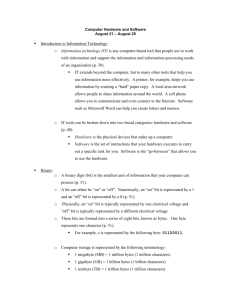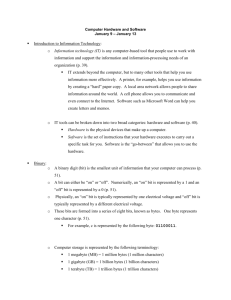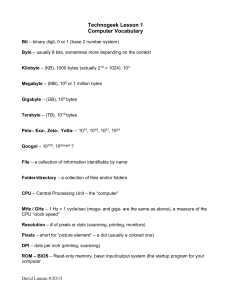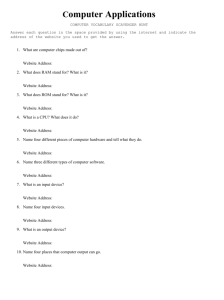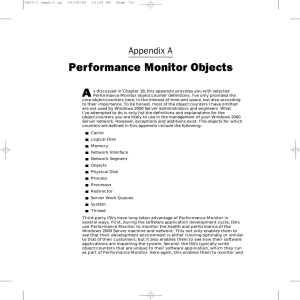Session 6
advertisement
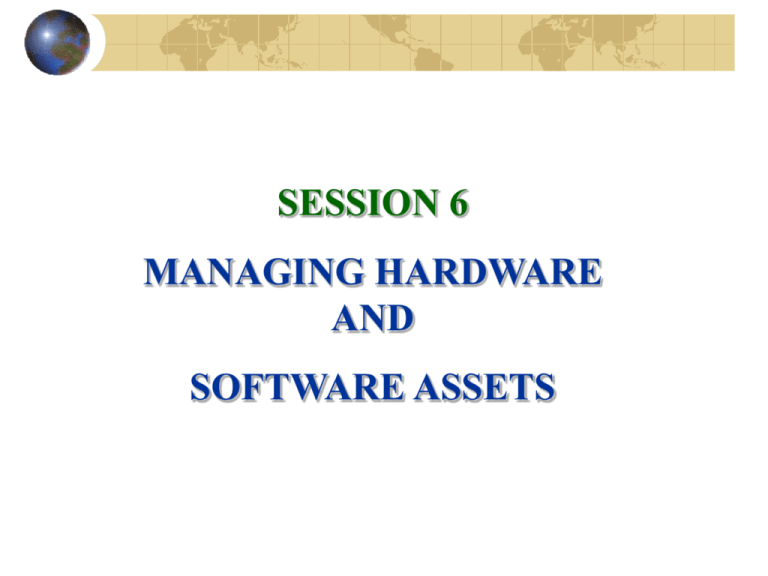
SESSION 6 MANAGING HARDWARE AND SOFTWARE ASSETS COMPUTER HARDWARE AND INFORMATION TECHNOLOGY INFRASTRUCTURE Hardware Components of a Computer System Figure 6-1 COMPUTER HARDWARE AND INFORMATION TECHNOLOGY INFRASTRUCTURE The Computer System bit Binary digit Represents smallest unit of data in the form of either 0 or 1 byte String of bits, usually eight Stores one number or character COMPUTER HARDWARE AND INFORMATION TECHNOLOGY INFRASTRUCTURE Bits and Bytes Figure 6-2 COMPUTER HARDWARE AND INFORMATION TECHNOLOGY INFRASTRUCTURE The CPU and Primary Storage Central Processing Unit (CPU) Manipulates symbols, numbers, and letters Controls other parts of the computer system COMPUTER HARDWARE AND INFORMATION TECHNOLOGY INFRASTRUCTURE The CPU and Primary Storage Arithmetic-logic unit (ALU): performs the computer’s principal logic and arithmetic operations Control Unit: coordinates and controls the other parts of the computer system COMPUTER HARDWARE AND INFORMATION TECHNOLOGY INFRASTRUCTURE Primary Storage Stores Software program being executed Operating system programs Data being used by program COMPUTER HARDWARE AND INFORMATION TECHNOLOGY INFRASTRUCTURE Primary Storage Computer storage capacity is measured in bytes: Kilobyte Megabyte Gigabyte Terabyte 1,000 bytes 1,000,000 bytes 1,000,000,000 bytes 1,000,000,000 bytes COMPUTER HARDWARE AND INFORMATION TECHNOLOGY INFRASTRUCTURE Computer Processing Parallel Processing Problem broken down into smaller parts Multiple instructions processed simultaneously with multiple processors COMPUTER HARDWARE AND INFORMATION TECHNOLOGY INFRASTRUCTURE Sequential and Parallel Processing Figure 6-4 STORAGE, INPUT AND OUTPUT TECHNOLOGY Secondary Storage Technology Magnetic disk: Floppy disk, Hard disk Optical disks: CD-ROM, DVDs Magnetic tape: Inexpensive, older secondary-storage medium New storage alternatives: Storage Area Networks (SANs) STORAGE, INPUT AND OUTPUT TECHNOLOGY Batch and On-Line Input and Processing Batch processing Transactions accumulated and stored until processing On-line processing Transactions are entered directly into computer and processed immediately CATEGORIES OF COMPUTERS AND COMPUTER SYSTEMS Classifying Computers Supercomputer: Highly sophisticated and powerful, performs complex computations Mainframes: Largest computer, massive memory, rapid processing power Midrange computers: Less powerful, less expensive, and smaller than a mainframe Network Server: Provides software and other resources to computers over a network Minicomputers: Middle-range computer, used in universities, factories, or research laboratories CATEGORIES OF COMPUTERS AND COMPUTER SYSTEMS Classifying Computers Personal Computer (PC): Small desktop or portable computer Workstation: Desktop computer with powerful graphics and mathematical capabilities CATEGORIES OF COMPUTERS AND COMPUTER SYSTEMS Computer Networks and Client/Server Computing • Distributed processing: Distribution of processing work among multiple computers • Centralized processing: Accomplished by one large central computer • Client/server computing: Splits processing between “clients” and “servers” on network CATEGORIES OF COMPUTERS AND COMPUTER SYSTEMS Network Computers and Peer-to-Peer Computing • Network computer (NC): Simplified desktop computer, does not store data permanently • Peer-to-peer computing: Distributed processing that links computers through Internet or private networks TYPES OF SOFTWARE • Software program: Series of statements or instructions to the computer • System software: Generalized programs, manages computer’s resources • Application software: Programs written to perform functions specified by end users TYPES OF SOFTWARE Figure 6-9 TYPES OF SOFTWARE Functions of the operating system • Allocates and assigns system resources • Schedules use of computer resources • Monitors computer system activities • Provides locations in primary memory for data and programs • Controls the input and output devices TYPES OF SOFTWARE Application Software and Programming Languages • Programming languages: Consists of 1s and 0s of binary code • Assembly language: Resembles machine language, substitutes mnemonics for numeric codes • Third-generation languages: FORTRAN, COBOL, BASIC, Pascal, and C TYPES OF SOFTWARE Fourth-Generation Languages and PC Software Tools • Fourth-generation language: Employed directly by end users • Natural languages: Close to human language TYPES OF SOFTWARE Software for Enterprise Integration: Enterprise Software and Middleware Middleware • Allows two disparate applications to communicate to exchange data Web server • Manages requests for Web pages on the computer where they are stored TYPES OF SOFTWARE Middleware Figure 6-18 HARDWARE TECHNOLOGY REQUIREMENTS Hardware Technology Requirements for Electronic Commerce and Digital Firm • Capacity planning: Process of predicting the computing power • Scalability: Ability of a computer, product, or system to expand and to serve without breaking down HARDWARE TECHNOLOGY REQUIREMENTS Total Cost of Ownership (TCO) of Technology Assets • Designates the total cost of owning technology resources • Includes initial purchase costs, cost of hardware and software upgrades, maintenance, technical support, and training HARDWARE TECHNOLOGY REQUIREMENTS Rent or Build Decisions: Using Technology Service Providers On-Line storage service providers • Third-party provider • Rent out storage space to subscribers over the Web • Allow customers to store and access data HARDWARE TECHNOLOGY REQUIREMENTS Rent or Build Decisions: Using Technology Service Providers Application Service Providers (ASPs) • Provide software that can be rented by other companies Other Types of Service Providers • Provide additional resources for helping organizations manage their technology assets




